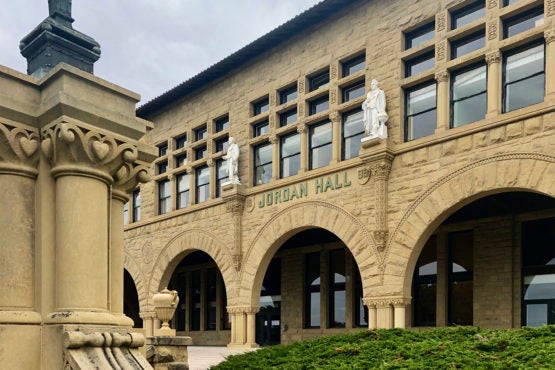Stanford to review requests for Jordan Hall renaming and statue removal
President Marc Tessier-Lavigne will appoint a committee to review requests that question views and practices of the university’s founding president and his mentor.
Stanford will review requests submitted by the Department of Psychology and a student-led group to rename Jordan Hall and remove a statue outside the building because of their namesakes’ promotion of particular doctrines.

Jordan Hall is home to the Department of Psychology, whose faculty members recently voted unanimously to request the name change and removal of the statue of Louis Agassiz. (Image credit: Kate Chesley)
Jordan Hall, then known as the Zoology building, was named in 1917 for David Starr Jordan (1851-1931). A prominent ichthyologist and Stanford’s founding president, he also was engaged in the American eugenics movement, which promoted controlled reproduction based on genetics.
The statue, which was placed above the building’s entrance in 1902, depicts Louis Agassiz (1807-1873), who was a mentor to Jordan but has no significant association with the university. Agassiz, a renowned scholar of natural history, promoted polygenism, which holds that human racial groups have different ancestral origins and are unequal.
Stanford President Marc Tessier-Lavigne said he will appoint a committee to review and report back on the two requests, following principles adopted in 2018 for considering the renaming of campus features named for historical figures with complex legacies.
Jordan Hall is home to the Department of Psychology, whose faculty members recently voted unanimously to request the name change and removal of the statue. They made their request in a letter from Professors Anthony Wagner, Steven O. Roberts, Greg Walton and Brian Wandell. Their request can be found here.
The Stanford Eugenics History Project, a group founded by Stanford undergraduate Ben Maldonado, also asked the university to rename the building. The group’s request can be found here.
In response, Tessier-Lavigne told the groups: “I will ask the committee to engage robustly with the campus community on the issues raised in the requests, which will not be possible to do at a distance during the COVID-19 shelter-in-place. Therefore, the committee will be convened when we have returned to campus in person.”
The principles for considering such renaming requests include a number of factors, including the harmful impact of a person’s behavior, the centrality of the behavior to the person’s life as a whole, the person’s relation to university history, community identification with the named feature, the strength and clarity of the historical evidence, possibilities for mitigation, and others.
Those principles guided the university’s decision in 2018 to rename some, but not all, campus features that had been named for Father Junipero Serra, the 18th-century founder of the California mission system. Those spaces include the newly renamed Jane Stanford Way, the pedestrian and bicycle mall along the front of the main Stanford campus; Carolyn Lewis Attneave House, home to the Clayman Institute for Gender Research; and Sally Ride House in the Stern Hall undergraduate residence complex. The name of Serra Street between Campus Drive East and El Camino Real was, however, retained.
A description of the considerations leading to the decision to retain the name on one feature but remove it from the others can be found on the Campus Names website.
